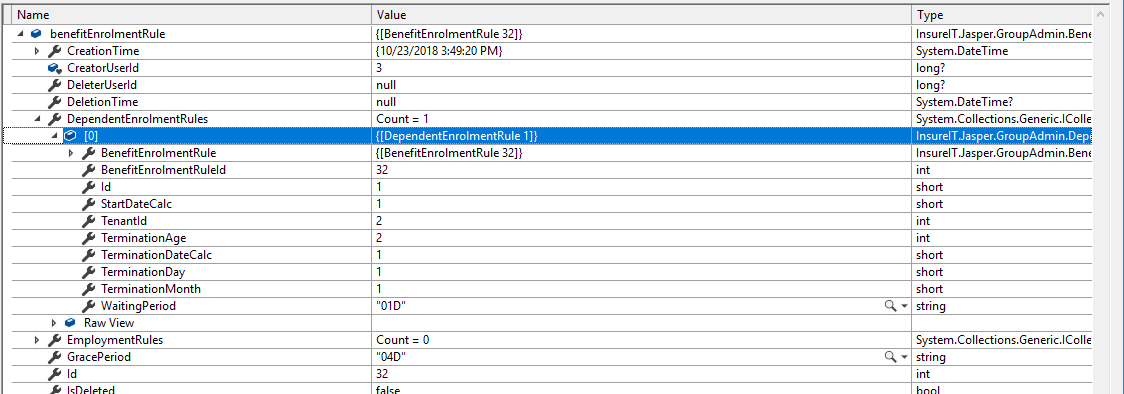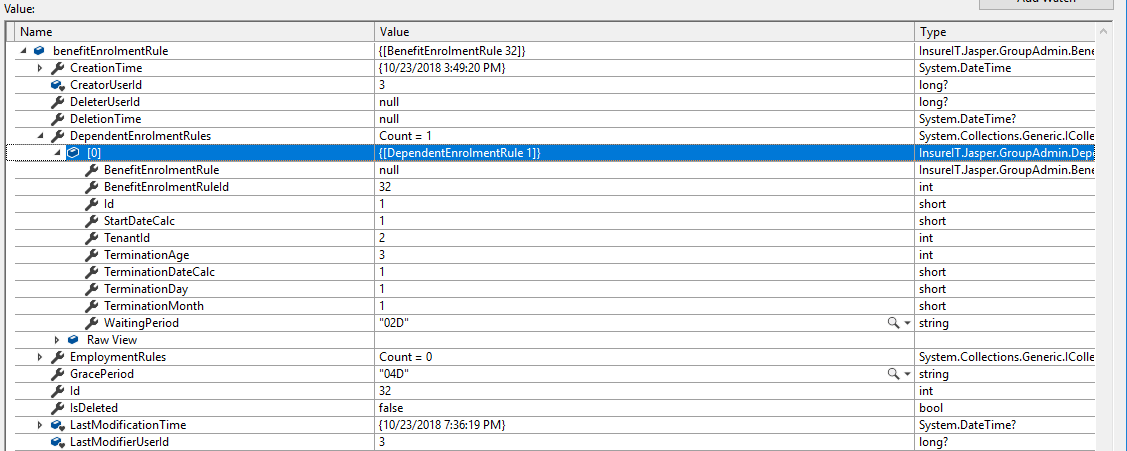Here is the scenario...
Entities
public partial class **BenefitEnrolmentRule** : FullAuditedEntity, IMustHaveTenant
{
public BenefitEnrolmentRule()
{
DependentEnrolmentRules = new HashSet<DependentEnrolmentRule>();
}
[Key]
[Column(Order = 1)]
public int TenantId { get; set; }
[Key]
[Column("BenefitEnrolmentRuleId", Order = 2)]
[DatabaseGenerated(DatabaseGeneratedOption.Identity)]
public override int Id { get; set; }
public bool? TrapLate { get; set; }
[Required]
[Column(TypeName = "char(3)")]
public string GracePeriod { get; set; }
public byte[] RecordVersion { get; set; }
[InverseProperty("BenefitEnrolmentRule")]
public ICollection<DependentEnrolmentRule> DependentEnrolmentRules { get; set; }
}
}
public partial class **DependentEnrolmentRule** : Entity<short>, IMustHaveTenant
{
[Key]
[Column(Order = 1)]
public int TenantId { get; set; }
[Key]
[Column("BenefitEnrolmentRuleId", Order = 2)]
public int BenefitEnrolmentRuleId { get; set; }
[Key]
[Column("Dependent", Order = 3)]
public override short Id { get; set; }
[Column(TypeName = "char(3)")]
public string WaitingPeriod { get; set; }
public short StartDateCalc { get; set; }
public int TerminationAge { get; set; }
public short TerminationDateCalc { get; set; }
[ForeignKey("TenantId,BenefitEnrolmentRuleId")]
[InverseProperty("DependentEnrolmentRules")]
public BenefitEnrolmentRule BenefitEnrolmentRule { get; set; }
}
}
Dto....
public class **BenefitEnrolmentRuleDto**
{
BenefitEnrolmentRuleDto()
{
}
public int TenantId { get; set; }
public int Id { get; set; }
public int BenefitOptionId { get; set; }
public bool? TrapLate { get; set; }
[Required]
public string GracePeriod { get; set; }
public List<DependentEnrolmentRuleCreateInputDto> DependentEnrolmentRules { get; set; }
}
public class **DependentEnrolmentRuleCreateInputDto**
{
DependentEnrolmentRuleCreateInputDto()
{
}
public int TenantId { get; set; }
public int BenefitEnrolmentRuleId { get; set; }
public short Dependent { get; set; }
public string WaitingPeriod { get; set; }
public short StartDateCalc { get; set; }
public int TerminationAge { get; set; }
public short TerminationDateCalc { get; set; }
public bool isEligible { get; set; }
}
Update Method
public async Task UpdateBenefitEnrolmentRule(BenefitEnrolmentRuleDto input)
{
var benefitEnrolmentRule = await _benefitEnrolmentRepository.GetAll()
.Include(e => e.DependentEnrolmentRules)
.Where(e => e.Id == input.Id)
.SingleOrDefaultAsync();
ObjectMapper.Map(input, benefitEnrolmentRule);
await _benefitEnrolmentRepository.UpdateAsync(benefitEnrolmentRule);
}
Data from Angualar client (Dto)
BenefitEnrolmentRules={
"tenantId":2,
"id":32,
"benefitOptionId":0,
"trapLate":true,
"gracePeriod":"04D",
"dependentEnrolmentRules":[
{
"tenantId":2,
"benefitEnrolmentRuleId":32,
"dependent":1,
"waitingPeriod":"02D",
"startDateCalc":1,
"terminationAge":3,
"terminationDateCalc":1,
"isEligible":true
}
]
}
After this statement in the update method var benefitEnrolmentRule = await _benefitEnrolmentRepository.GetAll() .Include(e => e.DependentEnrolmentRules) .Where(e => e.Id == input.Id) .SingleOrDefaultAsync();
After this statement in the update method ObjectMapper.Map(input, benefitEnrolmentRule);
After last statement in update method await _benefitEnrolmentRepository.UpdateAsync(benefitEnrolmentRule);
Checking the profiler,
SQL profiler Statements exec sp_executesql N'SET NOCOUNT ON; UPDATE [BenefitEnrolmentRule] SET [CreationTime] = @p0, [CreatorUserId] = @p1, [DeleterUserId] = @p2, [DeletionTime] = @p3, [GracePeriod] = @p4, [IsDeleted] = @p5, [LastModificationTime] = @p6, [LastModifierUserId] = @p7, [TrapLate] = @p8 WHERE [TenantId] = @p9 AND [BenefitEnrolmentRuleId] = @p10 AND [RecordVersion] = @p11; SELECT [RecordVersion] FROM [BenefitEnrolmentRule] WHERE @@ROWCOUNT = 1 AND [TenantId] = @p9 AND [BenefitEnrolmentRuleId] = @p10; ',N'@p9 int,@p10 int,@p0 datetime2(7),@p1 bigint,@p2 bigint,@p3 datetime2(7),@p4 varchar(3),@p5 bit,@p6 datetime2(7),@p7 bigint,@p11 varbinary(8),@p8 bit',@p9=2,@p10=32,@p0='2018-10-23 15:49:20.5956672',@p1=3,@p2=NULL,@p3=NULL,@p4='04D',@p5=0,@p6='2018-10-23 16:52:05.2990144',@p7=3,@p11=0x000000000000568D,@p8=1
exec sp_executesql N'SET NOCOUNT ON; UPDATE [DependentEnrolmentRule] SET [TerminationAge] = @p0, [WaitingPeriod] = @p1 WHERE [TenantId] = @p2 AND [BenefitEnrolmentRuleId] = @p3 AND [Dependent] = @p4; SELECT @@ROWCOUNT; ',N'@p2 int,@p3 int,@p4 smallint,@p0 int,@p1 varchar(3)',@p2=2,@p3=32,@p4=1,@p0=3,@p1='02D'
exec sp_executesql N'SET NOCOUNT ON; **DELETE FROM [DependentEnrolmentRule] WHERE [TenantId] = @p0 AND [BenefitEnrolmentRuleId] = @p1 AND [Dependent] = @p2; SELECT @@ROWCOUNT; ',N'@p0 int,@p1 int,@p2 smallint',@p0=2,@p1=32,@p2=1 ** Problem: In UpdateAsync method, it is updating the DependentEnrolmentRule and next step is, it is deleting the same record (see sql profile statements). Not sure why.
One reason I was thinking is, In GetAll, BenefitEnrolmentRule object in the DependentEnrolmentRule (which is associated by FK) has data and after mapping with input object,BenefitEnrolmentRule in the DependentEnrolmentRule is null.
- How to avoid getting BenefitEnrolmentRule in the DependentEnrolmentRule (as this is already a parent object, why do I need it again for child), why it is retrieved in child object too.
- How can I fix this issue without writing ForEach loop for DependentEnrolmentRule and update.
- Am I doing something wrong.
Please let me know how to fix this issue. I have posted all the code here. Really appreciate your help.
Thanks
5 Answer(s)
-
0
- How to avoid getting BenefitEnrolmentRule in the DependentEnrolmentRule (as this is already a parent object, why do I need it again for child), why it is retrieved in child object too.
From https://docs.microsoft.com/en-us/ef/core/querying/related-data#eager-loading:
Entity Framework Core will automatically fix-up navigation properties to any other entities that were previously loaded into the context instance. So even if you don't explicitly include the data for a navigation property, the property may still be populated if some or all of the related entities were previously loaded.
Related: https://github.com/aspnet/EntityFrameworkCore/issues/11564
- How can I fix this issue without writing ForEach loop for DependentEnrolmentRule and update.
Try these:
i. Don't query
BenefitEnrolmentRuleunnecessarily:public async Task UpdateBenefitEnrolmentRule(BenefitEnrolmentRuleDto input) { var benefitEnrolmentRule = ObjectMapper.Map<BenefitEnrolmentRule>(input); await _benefitEnrolmentRepository.UpdateAsync(benefitEnrolmentRule); }ii. Don't include
DependentEnrolmentRulesunnecessarily:public async Task UpdateBenefitEnrolmentRule(BenefitEnrolmentRuleDto input) { var benefitEnrolmentRule = await _benefitEnrolmentRepository.GetAll() .Where(e => e.Id == input.Id) .SingleOrDefaultAsync(); ObjectMapper.Map(input, benefitEnrolmentRule); await _benefitEnrolmentRepository.UpdateAsync(benefitEnrolmentRule); }iii. Specify
.AsNoTracking():public async Task UpdateBenefitEnrolmentRule(BenefitEnrolmentRuleDto input) { var benefitEnrolmentRule = await _benefitEnrolmentRepository.GetAll() .Include(e => e.DependentEnrolmentRules) .Where(e => e.Id == input.Id) .AsNoTracking() .SingleOrDefaultAsync(); ObjectMapper.Map(input, benefitEnrolmentRule); await _benefitEnrolmentRepository.UpdateAsync(benefitEnrolmentRule); }- Am I doing something wrong.
For starters:
- Always specify whether you are using ASP.NET Core (EF Core) or MVC 5 (EF6).
- Format code properly.
-
0
Hi Aaron,
Thanks for the quick response. **For the first suggestion I get following error **
_Abp.Domain.Uow.AbpDbConcurrencyException: Database operation expected to affect 1 row(s) but actually affected 0 row(s). Data may have been modified or deleted since entities were loaded. See http://go.microsoft.com/fwlink/?LinkId=527962 for information on understanding and handling optimistic concurrency exceptions. ---> Microsoft.EntityFrameworkCore.DbUpdateConcurrencyException: Database operation expected to affect 1 row(s) but actually affected 0 row(s). Data may have been modified or deleted since entities were loaded. See http://go.microsoft.com/fwlink/?LinkId=527962 for information on understanding and handling optimistic concurrency exceptions.In SQL profile, I see only update for BenefitEnrolmentRule. no update statements for DependentEnrolmentRules .
For the second suggestion, I get the following error
An error occurred while updating the entries. See the inner exception for details. Microsoft.EntityFrameworkCore.DbUpdateException: An error occurred while updating the entries. See the inner exception for details. ---> System.Data.SqlClient.SqlException: Violation of PRIMARY KEY constraint 'PK_DEPENDENTENROLMENTRULE'. Cannot insert duplicate key in object 'dbo.DependentEnrolmentRule'. The duplicate key value is (2, 32, 1).In the SQL profiler... I see Update for BenefitEnrolmentRule and insert for DependentEnrolmentRules instead of update for DependentEnrolmentRules.
For the third suggestion, no error. But In SQL profile, I see only update for BenefitEnrolmentRule. no update statements for DependentEnrolmentRules .
Thanks
-
0
Specify
Idinstead ofDependentin your DTO. -
0
Hi aaron,
I have custom mapping for id and dependent
configuration.CreateMap<DependentEnrolmentRuleCreateInputDto, DependentEnrolmentRule>() .ForMember(d => d.Id, options => options.MapFrom(s => s.Dependent)) .ForMember(u => u.BenefitEnrolmentRule, options => options.Ignore());[edited]
-
0
Hi @mmukkara
Have you solved the problem ?





